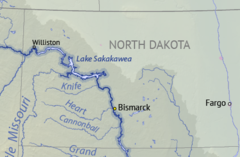
Back Lake Sakakawea CEB Lake Sakakawea German Lago Sakakawea Spanish Lac Sakakawea French Lago Sakakawea Italian Sakakavijos tvenkinys Lithuanian Lake Sakakawea NB Сакакавиа Russian Сакакавија (језеро) Serbian 沙卡卡威亞湖 Chinese
| Lake Sakakawea | |
|---|---|
 Lake Sakakawea highlighted in light blue on Missouri River Basin map | |
Location in the United States Location in North Dakota | |
| Location | |
| Coordinates | 47°30′N 101°25′W / 47.50°N 101.41°W at Garrison Dam |
| Lake type | Reservoir |
| Primary inflows | Missouri River, Little Missouri River, Milk River, and Yellowstone River. |
| Primary outflows | Missouri River |
| Catchment area | 317,400 km2 (122,500 sq mi) |
| Max. length | 178 miles (286 km) |
| Surface area | 307,000 acres (480 sq mi; 1,240 km2) |
| Max. depth | 180 ft (55 m) at dam |
| Water volume | 23,800,000 acre⋅ft (29.4 km3)[1] |
| Shore length1 | 1,320 miles (2,120 km) |
| Surface elevation | 1,817 ft (554 m)[1] |
| Settlements | Williston, Pick City, Four Bears Village, and Riverdale, North Dakota |
| References | [1] |
| 1 Shore length is not a well-defined measure. | |
Lake Sakakawea is a large reservoir in the north central United States, impounded in 1953 by Garrison Dam, a U.S. Army Corps of Engineers dam located in the Missouri River basin in central North Dakota. Named for the Shoshone-Hidatsa woman Sacagawea (who accompanied the Lewis and Clark Expedition), it is the largest man-made lake located entirely within North Dakota, the second largest in the United States by area after Lake Oahe, and the third largest in the United States by volume, after Lake Mead and Lake Powell.
The lake is located about fifty miles (80 km) from the state capital of Bismarck; the distance by the Missouri River is about 75 miles (120 km). The lake's width averages between 2–3 miles (3–5 km), with a maximum of 14 miles (23 km) at Van Hook Arm. Lake Sakakawea marks the maximum southwest extent of glaciation during the ice age. The lake is located within the counties of: Dunn, McKenzie, McLean, Mercer, Mountrail, and Williams.
- ^ a b c United States Army Corps of Engineers, Omaha District. "Archived copy". Archived from the original on 2007-07-26. Retrieved 2007-07-16.
{{cite web}}: CS1 maint: archived copy as title (link) Accessed 16 July 2007.

